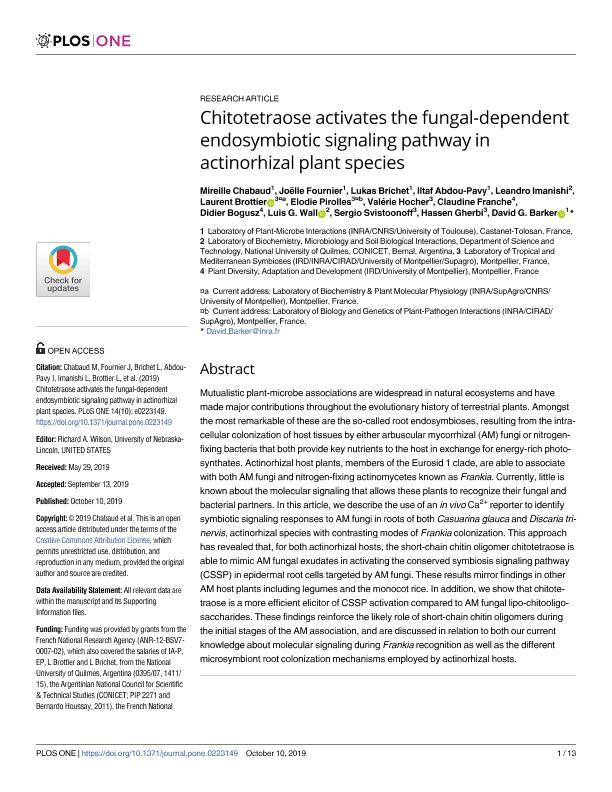Artículo
Chitotetraose activates the fungal-dependent endosymbiotic signaling pathway in actinorhizal plant species
Chabaud, Mireille; Fournier, Joëlle; Brichet, Lukas; Abdou Pavy, Iltaf; Imanishi, Leandro Ezequiel ; Brottier, Laurent; Pirolles, Elodie; Hocher, Valérie; Franche, Claudine; Bogusz, Didier; Wall, Luis Gabriel
; Brottier, Laurent; Pirolles, Elodie; Hocher, Valérie; Franche, Claudine; Bogusz, Didier; Wall, Luis Gabriel ; Svistoonoff, Sergio; Gherbi, Hassen; Barker, David G.
; Svistoonoff, Sergio; Gherbi, Hassen; Barker, David G.
 ; Brottier, Laurent; Pirolles, Elodie; Hocher, Valérie; Franche, Claudine; Bogusz, Didier; Wall, Luis Gabriel
; Brottier, Laurent; Pirolles, Elodie; Hocher, Valérie; Franche, Claudine; Bogusz, Didier; Wall, Luis Gabriel ; Svistoonoff, Sergio; Gherbi, Hassen; Barker, David G.
; Svistoonoff, Sergio; Gherbi, Hassen; Barker, David G.
Fecha de publicación:
10/2019
Editorial:
Public Library of Science
Revista:
Plos One
ISSN:
1932-6203
Idioma:
Inglés
Tipo de recurso:
Artículo publicado
Clasificación temática:
Resumen
Mutualistic plant-microbe associations are widespread in natural ecosystems and have made major contributions throughout the evolutionary history of terrestrial plants. Amongst the most remarkable of these are the so-called root endosymbioses, resulting from the intracellular colonization of host tissues by either arbuscular mycorrhizal (AM) fungi or nitrogen-fixing bacteria that both provide key nutrients to the host in exchange for energy-rich photosynthates. Actinorhizal host plants, members of the Eurosid 1 clade, are able to associate with both AM fungi and nitrogen-fixing actinomycetes known as Frankia. Currently, little is known about the molecular signaling that allows these plants to recognize their fungal and bacterial partners. In this article, we describe the use of an in vivo Ca2+ reporter to identify symbiotic signaling responses to AM fungi in roots of both Casuarina glauca and Discaria trinervis, actinorhizal species with contrasting modes of Frankia colonization. This approach has revealed that, for both actinorhizal hosts, the short-chain chitin oligomer chitotetraose is able to mimic AM fungal exudates in activating the conserved symbiosis signaling pathway (CSSP) in epidermal root cells targeted by AM fungi. These results mirror findings in other AM host plants including legumes and the monocot rice. In addition, we show that chitotetraose is a more efficient elicitor of CSSP activation compared to AM fungal lipo-chitooligosaccharides. These findings reinforce the likely role of short-chain chitin oligomers during the initial stages of the AM association, and are discussed in relation to both our current knowledge about molecular signaling during Frankia recognition as well as the different microsymbiont root colonization mechanisms employed by actinorhizal hosts.
Palabras clave:
SYMBIOSIS
,
MICORRHIZA
,
FRANKIA
,
ACTINORHIZA
Archivos asociados
Licencia
Identificadores
Colecciones
Articulos(SEDE CENTRAL)
Articulos de SEDE CENTRAL
Articulos de SEDE CENTRAL
Citación
Chabaud, Mireille; Fournier, Joëlle; Brichet, Lukas; Abdou Pavy, Iltaf; Imanishi, Leandro Ezequiel; et al.; Chitotetraose activates the fungal-dependent endosymbiotic signaling pathway in actinorhizal plant species; Public Library of Science; Plos One; 14; 10; 10-2019; 1-13; e0223149
Compartir
Altmétricas



